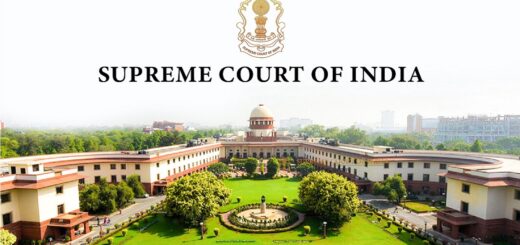A decision is considered per incuriam only if it ignores an important law or legal precedent that is key to the legal matter, according to the Supreme Court.

The Supreme Court noted that a decision is considered per incuriam only if the ignored law or legal precedent is crucial to the legal matter at hand and could have changed the result if it had been taken into account. This was highlighted in a civil appeal by M/s Bajaj Alliance General Insurance Co. Ltd. A Constitution Bench explained that someone with a license to drive a ‘light motor vehicle’ (LMV) is automatically allowed to drive a light transport vehicle weighing up to 7500 kilograms. The five-Judge Bench, which included CJI D.Y. Chandrachud and Justices Hrishikesh Roy, P.S. Narasimha, Pankaj Mithal, and Manoj Misra, stated, “When considering the ignorance of a statutory provision, we should keep in mind the following principles, which are not exhaustive:
(1) A decision is per incuriam only if the ignored law or precedent is essential to the legal issue and could have led to a different result if considered. It must be a conflicting provision and a clear case of significant omission.
(2) The per incuriam doctrine applies strictly to the main reasoning of the decision and not to incidental comments.
(3) If a court questions the validity of a precedent, it should either follow it or refer it to a larger Bench for review.
(4) To apply the per incuriam principle, it must be shown that part of the decision was based on clearly incorrect reasoning. In rare cases, if a judgment overlooks a clear statutory provision or mandatory authority that contradicts the reasoning and outcome, the per incuriam principle may apply.”
A two-Judge Bench, consisting of Justice Kurian Joseph and Justice Arun Mishra, addressed the case of Mukund Dewangan v. Oriental Insurance Co. Ltd. (2016) 4 SCC 298. They recognized differing opinions in eight previous Supreme Court judgments and posed questions for a three-Judge Bench to resolve. Justice Arun Mishra represented the Bench that answered these questions in Mukund Dewangan v. Oriental Insurance Co. Ltd. (2017) 14 SCC 663. The conclusion was that a holder of a ‘Light Motor Vehicle’ license does not need a separate endorsement to drive a ‘transport vehicle’ if it is classified as a ‘Light Motor Vehicle’ (weighing under 7,500 kgs). However, this decision did not settle the issue. In M/s. Bajaj Alliance General Insurance Co. Ltd. v. Rambha Devi & Ors. (2019) 12 SCC 816, the Court pointed out that the three-Judge Bench in Mukund Dewangan (2017) overlooked key sections of the Motor Vehicles Act, 1988 (MV Act) and its rules.
The Court then referred the request to reconsider the Mukund Dewangan (2017) ruling to a larger bench. The three-Judge Bench highlighted additional provisions that were missed in the earlier case, and since this concern was raised by a Bench of equal strength, it was deemed suitable to escalate the matter to a five-Judge Bench. Therefore, the validity of Mukund Dewangan (2017) was set to be reassessed. Due to ongoing consultations by the government, the case was postponed several times. In this context, the Supreme Court remarked, “In a recent decision in Shah Faesal v. Union of India, a five-judge bench of this Court reiterated that the principle of per incuriam only applies on the ratio of the case.”
The Court stated that the overlooked provisions would not change the final decision, so the ruling in Mukund Dewangan (2017) should remain intact and not be affected by the principles of per incuriam. It emphasized the importance of using empirical data and staying within the law’s framework. While acknowledging road safety concerns, the Court pointed out that creating policy is the responsibility of the legislature, not the court. It highlighted the need to respect institutional limits in addressing these issues. Additionally, the Court noted that if Parliament had acted earlier to amend the MV Act and clearly defined different classes and categories, much of the confusion around driving licenses could have been resolved, leading to less litigation and clearer laws. The Court remarked on the ongoing confusion and inconsistency in judicial decisions since the 1999 Ashok Gangadhar Maratha case. It also highlighted that road safety is a major public health issue worldwide, with over 1.7 lakh fatalities in India due to road accidents in 2023. The reasons for these accidents are varied, and the assumption that they are mainly caused by drivers of light transport vehicles with an LMV license is unfounded. The Court pointed out that careless driving, speeding, poor road design, and failure to follow traffic laws contribute to accidents, along with other factors like mobile phone use, fatigue, and not wearing seat belts or helmets.
The licensing rules under the MV Act and MV Rules do not require a separate endorsement for driving a ‘Transport Vehicle’ if a driver already has a LMV license. However, it is important to note that exceptions for special vehicles like e-carts, e-rickshaws, and those carrying hazardous materials will not be affected by this Court’s decision. The Court stressed that both the definition in Section 2(21) and the requirement in Section 3(1) for a driving license for a ‘Transport Vehicle’ must remain relevant and not be ignored. The focus on ‘Transport Vehicle’ in the licensing framework should only relate to ‘medium’ and ‘heavy’ vehicles.
In today’s world, where driverless vehicles and app-based transport services are common, the licensing system needs to evolve. The recent changes made by the Indian legislature may not cover all issues. The Learned Attorney General mentioned that legislative updates are in progress, and we hope for a thorough amendment to fix existing gaps. The Court, therefore, highlighted several key points-
- A driver with a Light Motor Vehicle (LMV) license, as stated in Section 10(2)(d) for vehicles weighing under 7,500 kg, can drive a ‘Transport Vehicle’ without needing extra permission under Section 10(2)(e) of the MV Act for that class. LMVs and Transport Vehicles are not completely distinct; there is some overlap. However, special eligibility rules still apply to e-carts, e-rickshaws, and vehicles that transport hazardous materials.
- The second part of Section 3(1), which highlights the need for a specific requirement to drive a ‘Transport Vehicle,’ does not override the LMV definition in Section 2(21) of the MV Act.
- The extra eligibility rules in the MV Act and MV Rules for driving ‘transport vehicles’ apply only to those who want to operate vehicles with a gross weight over 7,500 kg, such as ‘medium goods vehicles,’ ‘medium passenger vehicles,’ ‘heavy goods vehicles,’ and ‘heavy passenger vehicles.’
- The ruling in Mukund Dewangan (2017) is confirmed, but for the reasons we have explained in this judgment. Since there is no significant omission, the decision is not considered per incuriam, even if some parts of the MV Act and MV Rules were not addressed in that judgment.
Cause Title- M/s Bajaj Alliance General Insurance Co. Ltd. v. Rambha Devi & Ors. (Neutral Citation: 2024 INSC 840)








